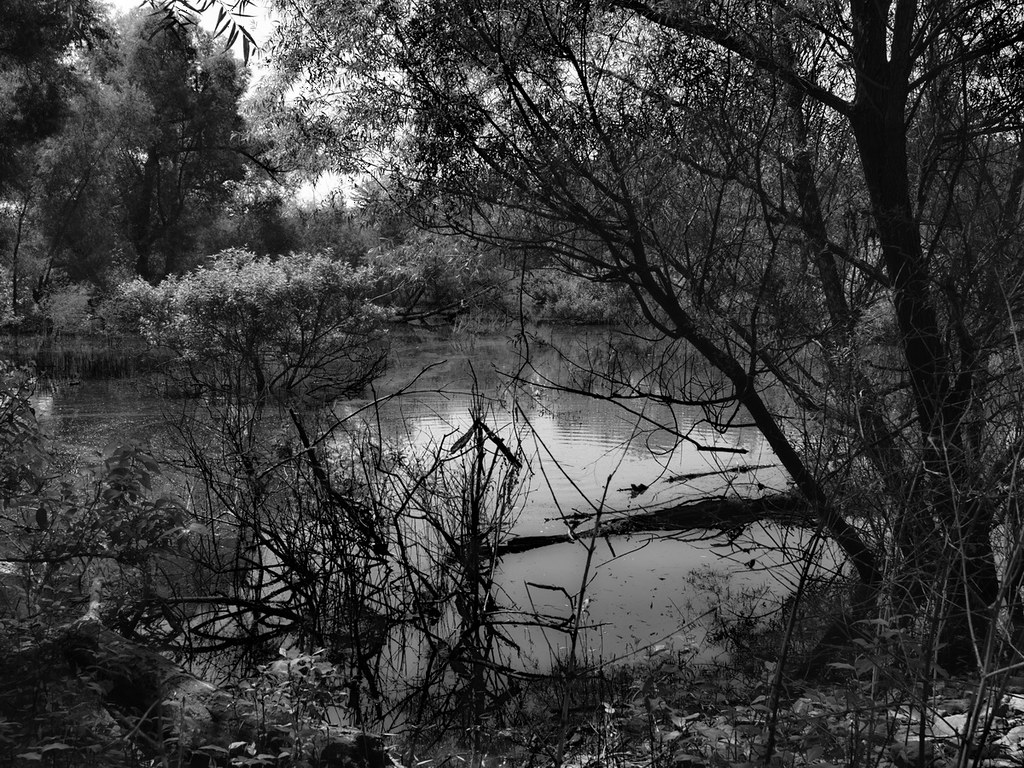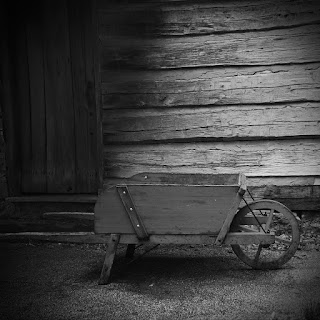Photomatix Pro 5.1 vs Affinity HDR vs PSP X8 HDR
 |
| Produced with Photomatix Pro 5.1 This looks very much how I remember the scene. click on the image to see a larger version |
There is an inherent unfairness in these sort of 'shootout' type articles that I don't really know how to overcome completely.
- The person doing the comparisons, generally knows one product better than the others, so the final product of the less well known products always suffer.
- The person doing the comparisons, generally has one of the products successfully incorporated into their post production workflow, and runs the risk of just complaining that the other products aren't the favored products. I've seen it happen in other reviews, and I really hate that!
- The person doing the comparisons, generally brings a whole host of other unstated assumptions and prejudices to the table that can complicate and shade his or her evaluation, but that the reader can only guess at.
Be advised that I am aware of these shortcomings in myself and have worked hard to overcome them. While I can't get rid of them completely, I think I have kept them under some level of control!
My favorite HDR photos are the more subtle more naturalistic photos, and not the 'over the top' tonemapped photos. Don't get me wrong, I do the other sort too; but I think modern HDR software makes it so easy to get those sort of Dramatic, 'kitschy' photos, that I think a test to produce more natural looking photos gives the HDR software a more thorough work out. I TRIED to get the final output from all three to look as much alike as I could. I was only modestly successful
Photomatix Pro 5.1
 |
| A screen shot of Photomatix 5.1 click on the image to see a larger version |
To be honest this was, and is still, my favorite. I love the level of control it offers and it allows me to produce almost any sort of HDR photo I want. But most importantly, it fits into my ACDSee centric PP workflow almost seamlessly.
All three HDR utilities will work with raw images, but Photomatix 5.1 also allows me to select a series of exposures in ACDSee, right click on the group and send them to Photomatix 5.1 for processing. This alone is a time saver for me. I will explain how the other two don't work as well in their respective sections.
It has a high degree of control in how it processes raw, a high degree of control in how it processes the merged photos, and a nice selection of color, tonality, and sharpening tools after the merged photo has been finalized. It is frequently possible to get to a finished product with JUST Photomatix 5.1 without any further editing in ACDSee Ultimate 10 or any other bit mapped editor.
Photomatix 5.1 comes with canned presets and allows the user to create his or her own presets as well.
The sample finished photo looks pretty much how I remember the scene when I took it.
Corel PaintShop Pro X8 HDR Utility
 |
| Produced with PaintShop Pro X8 HDR Utility. I particularly liked how the water looks in this version. click on the image to see a larger version |
This was my first HDR utility, and it is surprisingly good. It's biggest drawback for me is that while I can select a series of exposures for processing and send them to PSP from ACDSee, I can't send them to the HDR utility.
I end up sending them to the Corel Raw Lab utility (the PSP Raw developer) if they are raw images, or to the PSP editor directly if they are tif or jpg images. To use the Corel PSP HDR utility, I have to find and select the images from the very basic, built in, PSP organizer.
 |
| A screen shot of PSP X8's HDR Utility Click on the image to see a larger version. |
I think if Corel wants to remain competitive with PSP, one of the things it needs to do is alter their HDR utility to accept raw images from any source, not just the PSP organizer or Aftershot Pro, which I believe also comes with the HDR Utility.
Software publishers seem to be terribly short sighted when it comes to doing things that might attract new users, so I don't expect this to happen! But hey! you never know with certainty!
What I like about PSP's HDR utility is that it sort of shows you what it is doing every step of the way and allows you some input in how each step occurs. The other two products, in an effort to make thing easy, kind of take automation further and you don't really get to see the 'sausage being made'!
It comes with a few standard presets and allows you to create your own. But when I upgraded from PSP X6 to X8, I don't recall any effort to bring my saved presets over from X6. (I haven't upgraded the other two to a new version, so I don't know if they are any better in that regard.)
 |
| Single Raw Photo, produced with PaintShop Pro X6 HDR Utility click on the image to see a larger version |
Another thing I REALLY like, is the Single Raw Photo option in the PSP X8 HDR utility. It literally creates 3 separate exposures from a single raw photo, and merges them as if they came from a series of three separate photos. As near as I can tell, Photomatix 5.1 just does tone mapping to a single raw image, I don't think it is creating multiple exposures from the raw and merging them.
The increased tonality capability of PSP's Single Raw Photo HDR utility is pretty amazing, and can match, if not occasionally, beat, ACDSee's Light EQ tool for squeezing out all the dynamic range a raw photo can offer.
Yes, the user interface can be a bit intimidating, especially to a newbie, there are a lot of options you won't see in other HDR utilities. But it isn't something the reasonably intelligent digital photographer can't get comfortable with in an hour's worth of practice. I consider it a useful tool in my toolbox.
Affinity HDR Utility
Affinity is getting all the buzz and chatter right now, especially since, from what I've read, the OnOne raw product seems somewhat disappointing to many people who were looking forward to seeing the production version (at least the buzz and chatter seems more negative, I haven't tried it), and everyone always seems to want to take Adobe Photoshop down a bit.
Affinity's raw development leaves a lot to be desired, but it's bit mapped editor is fairly good, though still a bit buggy. The Affinity HDR module which needs elements of both seems to reflect this disjointed level of completeness, in my mind.
In many ways Affinity gets many HDR things right, and certainly, it is the only HDR utility of the three that offers a Curves tool for controlling tonality.
It's a pretty automated process, and that makes it VERY easy to create HDR photos. It also has the ability to use and create presets.
The problem is, I can't tell if the controls are a part of the post merge, pre finalization step or are just the standard bit mapped controls showing up to do THEIR thing!
It also can't accept a series of raw files from ACDSee and process them as HDR. They go automatically to the raw develop persona as multiple instances of the persona, and I can't figure out how to get them to the HDR input window without going through the very primitive, standard Windows open file popup window.
 |
| Produced with Affinity Photo's HDR Utility click on the image to see a larger version |
To the good, once you get past the Windows selection popup window, creating HDRs is incredibly easy, and the output looks pretty good. I don't think it is as good as Photomatix or Paintshop pro, but it is a whole lot easier to produce.
My suspicion is that Serif (the software developer and publisher of Affinity photo), sees the HDR utility as something that is designed to produce a fairly decent HDR exposure that you can finish up in the Affinity Photo bit mapped editor. That is as valid an approach as Photomatix's "do as much as possible inside Photomatix" approach, I think since the Affinity Photo bit mapped editor is so complete. But I do think it complicates things for people trying to do product comparisons!
My Conclusions
I would rate the output of this test to be:
- Photomatix Pro 5.1
- Corel PaintShop Pro X8
- Serif's Affinity Photo 1.5
Photomatix Pro 5.1 works well for me and fits well within my normal workflow. I can do HDR quickly and easily with an ACDSee/Photomatix combination. PSP X8's HDR utility while not as convenient to use as Photomatix, offers me a different approach to HDR that I like to have available.
Affinity's HDR module is not likely something I will use much. While it is really easy to use, and produces fairly good results, I don't think it offers me, who is about to make the transition from a beginner HDR creator to an intermediate HDR creator, much that the other two products don't offer in better, more efficient ways. It would be good for people who want to explore HDR without spending much money though.
I don't see this as a negative about Affinity Photo, overall. It is a remarkable product in many ways, though it has a long way to go before it can offer PSP or Photoshop any serious competition. I'm glad I purchased Affinity Photo, and I look forward to using its non HDR functions in the future, especially as Serif brings it up to a tested ready state.
































